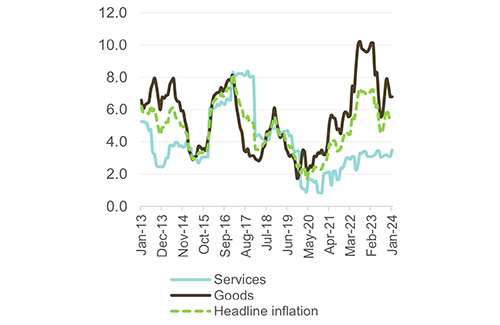Domestic inflation is expected to gradually slowdown during 2024,which could result in a more stable cost of living scenario. Economic forecasts indicate Namibian inflation should decelerate from 6.1% in 2022 to 5.9% in 2023 and further to approximately 4.9% in 2024.
This is according to Simonis Storm that stated Namibia’s annual inflation for January 2024 stood of 5.4% year-on-year (y/Y), down from 7.0% y/y recorded in January 2023 but slightly up from 5.3% y/y recorded in December 2023.
“This is the second highest inflation rate recorded at the beginning of the year since January 2017. Furthermore, the monthly inflation for January 2024 rose to 1.3% compared to the 0.1% deflation reported in December 2023. This increase represents the highest month-on-month figure since April 2022,” SS stated in its January inflation report.
Meanwhile, food and non-alcoholic beverages remained the primary drivers of inflation, contributing 1.3 percentage points to the headline inflation rate of 5.4% y/y in January 2024. Following closely, the housing, water, and electricity category contributed 1.1 percentage points, while alcoholic beverages and tobacco contributed 1.0 percentage points. Other categories made contributions below one percentage point.
In January 2024, the Northern regions saw an annual inflation rate of 5.5% y/y, the Khomas region 5.7% y/y, and Hardap,
//Kharas, Omaheke and Erongo regions registered the lowest zonal annual inflation rate of 5.0% y/y.
Services inflation continued to exert pressure on headline inflation, rising to 3.5% y/y in January 2024 from 3.1% y/y in both January and December 2023, marking the highest level since 2019. Meanwhile, goods inflation remained steady at 6.8% y/y compared to 6.8% y/y recorded in December 2023 but slowed down from 9.8% y/y in January 2023.
The transport category, which historically played a substantial role in driving the annual inflation rate, experienced a notable slowdown in inflation to 6.1% y/y in January 2024, down from 11.1% y/y in January 2023. However, there was an increase from the 4.0% y/y recorded in December 2023. This deceleration in the annual inflation rate can be attributed to factors within the subcategories of operation of personal transport equipment and public transport services such as petrol and diesel prices.
The SS report pointed out that this trend aligns with the United Nations Food and Agricultural Organisation (FAO) food index, which reported that global wheat export prices declined in January due to intense competition among exporters and increased supplies from southern hemisphere nations.
“Similarly, maize export prices witnessed a significant decrease, driven by favourable crop conditions and the onset of the harvest in Argentina, coupled with increased supplies in the United States following revised production estimates. Prices of barley and sorghum also followed this downward trajectory,” SS stated.
The SS report added that the fruits subcategory also saw a slowdown in its inflation rate, mainly driven by lower price levels for avocados and watermelons. Equally, mineral waters, soft drinks, and juices experienced a slower rise in prices, particularly in the case of fruit juices and squashes.
“When comparing prices on an annual basis, only fish, coffee, tea, cocoa, milk, cheese, and eggs experienced an increase in their price levels in January 2024,” SS stated.


